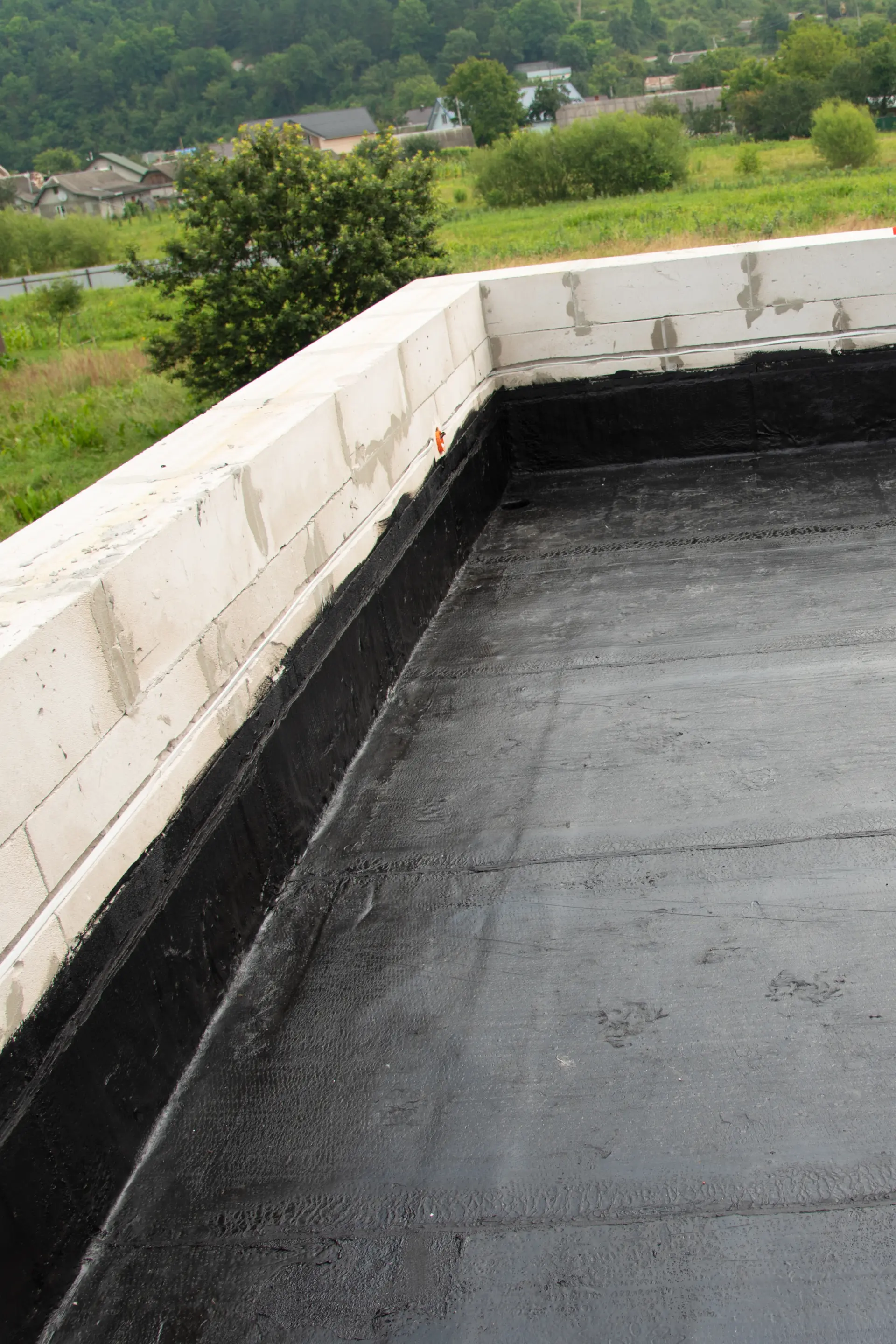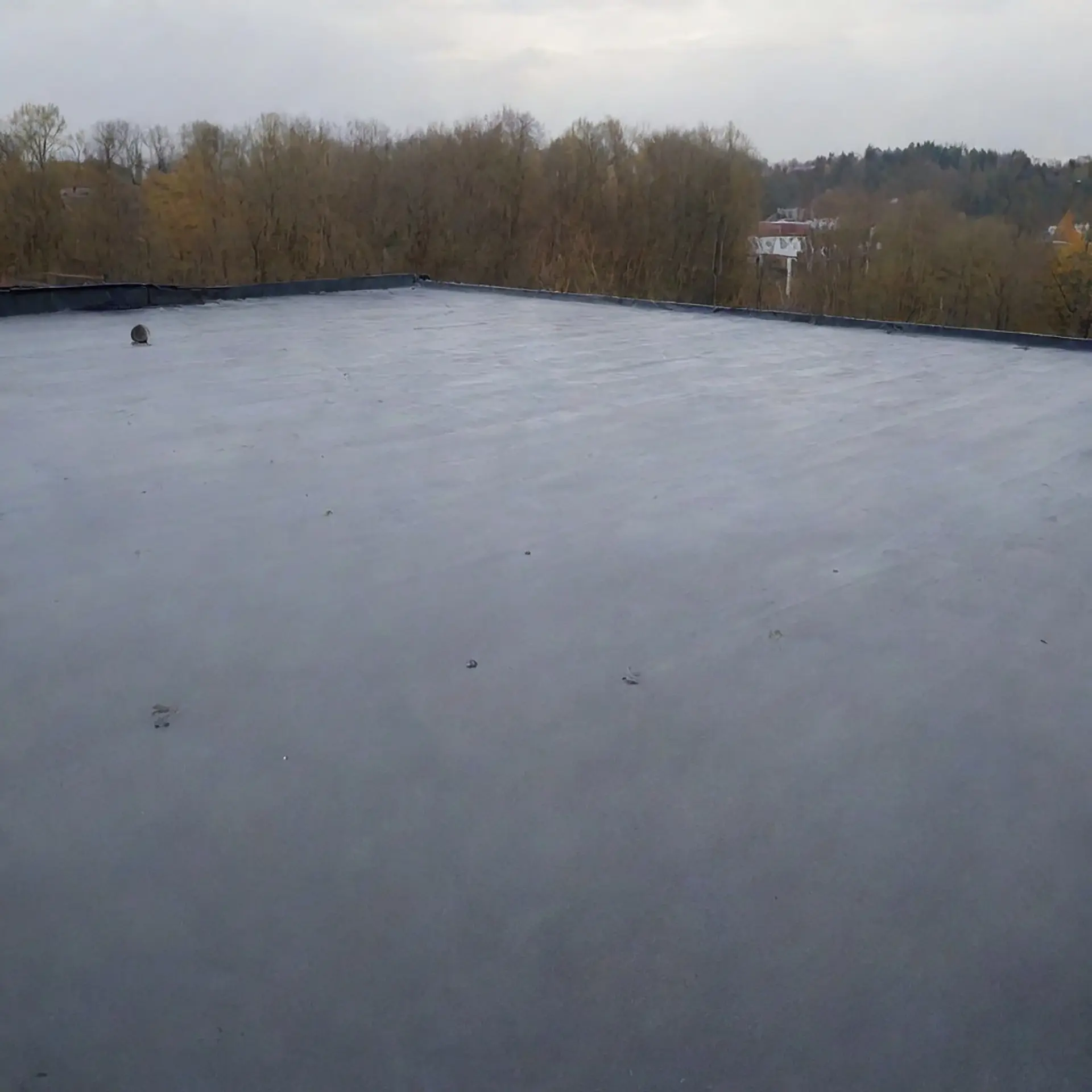Explore common flat roof problems and how to fix them. Discover practical solutions to ponding water, leaks, mould growth & surface damage. Prevention tips included.
What Causes Ponding Water?
Ponding water is when water collects and stays on a flat roof for more than 48 hours after rain. Unlike sloped roofs, flat roofs don’t drain as easily, so they need to be designed with a slight slope to help water flow towards drains or gutters.
One major cause of ponding water is poor drainage. If the roof’s drains are blocked by leaves, dirt, or debris, water has nowhere to go. Another common issue is sagging, which happens when part of the roof structure sinks over time, creating a dip where water collects.
If a flat roof isn’t installed correctly or the materials have worn out, the surface might not be even, leading to water pooling in certain areas. Over time, this can damage the roofing material and lead to leaks or even structural issues.
To fix ponding water, clear out any blocked drains or gutters regularly. If the problem is sagging, a roofing professional might need to strengthen the structure. Sometimes, adding extra drainage points or applying a new waterproof layer can help direct water away from trouble spots. Keeping an eye on water build-up and taking action quickly can prevent bigger issues down the line.

How to Identify a Leaking Flat Roof
A leaking flat roof can cause serious damage inside a building. Finding the source of the leak early can save time and money on repairs. Here are some signs to watch out for:
Water Stains on Ceilings or Walls
If you see brown or yellow stains on the ceiling or walls, it’s a sign that water is getting through the roof. These stains may get bigger after heavy rain.
Even if you don’t see water dripping, these marks are a warning that moisture is seeping through the roof layers.
Dripping Water or Damp Patches
Sometimes, you might see actual water dripping from the ceiling or notice damp spots on the floor. This often means the leak is already serious and needs fixing quickly.
If the leak is near a light fixture or electrical wiring, it can be dangerous and should be addressed immediately.
Mould and Mildew Growth
Damp conditions from a leak can cause mould and mildew to grow. If you notice a musty smell or see black or green patches on walls or ceilings, there could be a hidden leak.
Mould can spread quickly and affect indoor air quality, making it important to fix the problem as soon as possible.
Roof Surface Damage
Check the roof for cracks, blisters, or loose materials. These can let water through and cause leaks inside. If you see standing water around these weak spots, it’s likely the water is seeping in.
Any bubbling or peeling of the roofing material can also indicate moisture damage.
Soft Spots on the Roof
Walk carefully on the roof (if safe) and check for soft or spongy areas. These spots suggest that water has soaked into the roofing layers and weakened the structure.
A soft roof can eventually lead to more serious problems, including structural damage.
Blocked Drains and Gutters
Flat roofs rely on proper drainage to prevent water from pooling. If the drains or gutters are blocked by leaves, debris, or dirt, water can accumulate on the roof’s surface.
Over time, this standing water can find its way through small cracks or weak areas, causing leaks. Regularly checking and clearing roof drains and gutters can help avoid water build-up and potential leaks.
Why Do Blisters and Bubbles Form?
Blisters and bubbles appear on flat roofs when air or moisture gets trapped under the roofing material. These raised bumps can weaken the roof over time, leading to leaks and further damage.
One common cause is poor installation. If the roofing material wasn’t properly attached or sealed, pockets of air can get trapped underneath. Temperature changes also play a role. On hot days, trapped air or moisture expands, pushing the roofing layers apart and creating bubbles. When the temperature drops, the bubbles shrink, but over time, this movement weakens the roof.
Moisture is another key reason for blisters. If water seeps into the roof’s layers due to small cracks or poor sealing, it can get trapped. When the sun heats the roof, the moisture turns into vapour, causing the surface to bulge. Repeated expansion and contraction make these blisters worse over time, eventually leading to cracks in the roofing membrane.
Another factor that can lead to blisters is using low-quality materials. Some roofing membranes are more prone to blistering, especially if they lack the flexibility to handle temperature changes. Improper ventilation can also make blisters more likely, as trapped heat and moisture worsen the problem.
To fix blisters, a roofer may need to cut away the damaged section, remove trapped air or moisture, and reseal the area with new material. In some cases, a full replacement of the affected area may be necessary. Preventing blisters involves using high-quality roofing materials, ensuring proper installation, and maintaining good roof ventilation. Regular inspections can help spot early signs of damage before they become a bigger problem.
Importance of Flashing in Flat Roofing
Flashing is a thin piece of metal or other material that helps seal the edges and joints of a flat roof. It stops water from seeping into gaps where different parts of the roof meet, such as around chimneys, vents, and edges.
If flashing is missing, loose, or damaged, water can get into the building, causing leaks and weakening the structure. Over time, exposure to wind, rain, and temperature changes can make flashing crack or peel away. Poorly installed flashing can also lead to gaps where water can enter, making the roof vulnerable to leaks.
To keep flashing in good condition, check it regularly for cracks, rust, or looseness. If it’s damaged, replacing it quickly can prevent bigger problems.

A roofer can reattach or install new flashing using waterproof sealants and strong materials like aluminium or rubber. Properly installed flashing should be securely fastened and sealed to prevent gaps from forming over time.
Another important aspect of flashing is ensuring it is compatible with the roofing material. Some metals, such as copper and aluminium, react differently when in contact with certain roofing products. Choosing the right flashing material helps prevent premature deterioration and ensures a longer-lasting seal.
Properly maintained flashing is essential for keeping a flat roof watertight and protecting the building from water damage. Regular inspections and prompt repairs will help prevent costly roof failures and extend the life of the roofing system.

How Poor Insulation Affects a Flat Roof
Poor insulation in a flat roof can lead to a range of hidden problems that might not be obvious straight away. When there isn’t enough insulation, heat can slip out of the building during cold weather, making rooms feel chilly and uncomfortable.
The heating system then has to work much harder to keep everyone warm. In the summer, the roof may allow too much heat inside, so people feel hot and sticky. These temperature swings can push up energy bills and leave you paying more than you should each month.
Another issue linked to poor insulation is condensation. This happens when warm, moist air inside meets a cold surface, such as the underside of your flat roof. Tiny droplets of water form on that surface and can gradually damage the roof’s materials.
Over time, the dampness can seep into wood and other parts of the structure, making them soft or weak. This dampness can also help mould and mildew grow in dark corners, leading to musty smells and possible health worries for people who spend time in the building.
A poorly insulated roof may also allow water to seep in more easily. When a flat roof doesn’t stay at a stable temperature, it can expand and contract in ways that weaken seals or joints. Cracks or gaps might form, giving water a way to get through.
Once water enters the roof layers, it can cause even more damage, like rot or stains on ceilings. Repairing these problems can cost a lot of money, especially if you need to replace large sections of the roof or fix the harm done to walls, floors, or other important parts of the building.
By making sure a flat roof has the correct type and amount of insulation, you help keep the building comfortable and lower your energy costs. You also lower the chance of moisture troubles that can shorten the roof’s lifespan. Spotting and fixing poor insulation early will help prevent big headaches, such as expensive repairs and health risks caused by dampness and mould.
Need a reliable flat roofing solution in Blackpool, Layton, or Kirkham? Paul Jones Roofing Contractor offers expert flat roof installations and repairs across the Fylde Coast, using durable materials for long-lasting protection.


